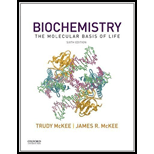
Concept explainers
To review:
The standard free energy change for the reaction
Introduction:
The phosphoryl group transfer potential of a compound can be defined as the measure of the strength of attachment of a group to the molecule. It refers to the differences in the standard free energy of the molecule with and without the group. NADH has a higher phosphoryl group transfer potential than FADH2 (flavin adenine dinucleotide).
Explanation of Solution
The reduction of oxygen to water by FADH2can be depicted as follows:
For calculating the standard free energy, thenumber of electrons transferred needs to be balanced. For a reaction, the standard free energy can be calculated by using the Nernst equation, which is as follows:
Where,
n is the number of electrons transferred,
F is Faraday’s constant, which is 96.15 kJ/V.mol (kilojoule per Volt. mole), and
∆E°’ is the overall cell potential.
∆E°’ is the overall cell potential.
∆E°’ can be calculated using the following formula:
In the given case, E°’ of electron acceptor is +0.82 V and that of electron donor is -0.22 V.
Putting the values of n, F, and ∆E°’ in the Nernst equation:
Thus, the standard free energy of the reaction is –199.992 kJ/mol.
The reduction of oxygen to water by NADH can be depicted as follows:
For calculating the standard free energy, the number of electrons transferred needs to be balanced. For a reaction, the standard free energy can be calculated by using the Nernst equation.
Thus,
The value of standard reduction potential (Eº’) for electron acceptor in this case is 0.82 V and for electron donor is –0.32 V. Therefore,
Putting the values of n, F, and ∆E°’ in the Nernst equation:
Thus, the standard free energy of the reaction is -219.222 kJ/mol.
Thus, it can be concluded that the standard free energy of reduction of oxygen to water by FADH2 is -199.992 kJ/mo, lnd the standard free energy of reduction of oxygen to water by NADH is -219.222 kJ/mol.
Want to see more full solutions like this?
Chapter 9 Solutions
Biochemistry, The Molecular Basis of Life, 6th Edition
- Which type of enzyme catalyses the following reaction? oxidoreductase, transferase, hydrolase, lyase, isomerase, or ligase.arrow_forward+NH+ CO₂ +P H₂N + ATP H₂N NH₂ +ADParrow_forwardWhich type of enzyme catalyses the following reaction? oxidoreductase, transferase, hydrolase, lyase, isomerase, or ligase.arrow_forward
- Which features of the curves in Figure 30-2 indicates that the enzyme is not consumed in the overall reaction? ES is lower in energy that E + S and EP is lower in energy than E + P. What does this tell you about the stability of ES versus E + S and EP versus E + P.arrow_forwardLooking at the figure 30-5 what intermolecular forces are present between the substrate and the enzyme and the substrate and cofactors.arrow_forwardprovide short answers to the followings Urgent!arrow_forward
- Pyruvate is accepted into the TCA cycle by a “feeder” reaction using the pyruvatedehydrogenase complex, resulting in acetyl-CoA and CO2. Provide a full mechanismfor this reaction utilizing the TPP cofactor. Include the roles of all cofactors.arrow_forwardB- Vitamins are converted readily into important metabolic cofactors. Deficiency inany one of them has serious side effects. a. The disease beriberi results from a vitamin B 1 (Thiamine) deficiency and ischaracterized by cardiac and neurological symptoms. One key diagnostic forthis disease is an increased level of pyruvate and α-ketoglutarate in thebloodstream. How does this vitamin deficiency lead to increased serumlevels of these factors? b. What would you expect the effect on the TCA intermediates for a patientsuffering from vitamin B 5 deficiency? c. What would you expect the effect on the TCA intermediates for a patientsuffering from vitamin B 2 /B 3 deficiency?arrow_forwardDraw the Krebs Cycle and show the entry points for the amino acids Alanine,Glutamic Acid, Asparagine, and Valine into the Krebs Cycle - (Draw the Mechanism). How many rounds of Krebs will be required to waste all Carbons of Glutamic Acidas CO2?arrow_forward
 Principles Of Radiographic Imaging: An Art And A ...Health & NutritionISBN:9781337711067Author:Richard R. Carlton, Arlene M. Adler, Vesna BalacPublisher:Cengage Learning
Principles Of Radiographic Imaging: An Art And A ...Health & NutritionISBN:9781337711067Author:Richard R. Carlton, Arlene M. Adler, Vesna BalacPublisher:Cengage Learning Anatomy & PhysiologyBiologyISBN:9781938168130Author:Kelly A. Young, James A. Wise, Peter DeSaix, Dean H. Kruse, Brandon Poe, Eddie Johnson, Jody E. Johnson, Oksana Korol, J. Gordon Betts, Mark WomblePublisher:OpenStax College
Anatomy & PhysiologyBiologyISBN:9781938168130Author:Kelly A. Young, James A. Wise, Peter DeSaix, Dean H. Kruse, Brandon Poe, Eddie Johnson, Jody E. Johnson, Oksana Korol, J. Gordon Betts, Mark WomblePublisher:OpenStax College BiochemistryBiochemistryISBN:9781305577206Author:Reginald H. Garrett, Charles M. GrishamPublisher:Cengage Learning
BiochemistryBiochemistryISBN:9781305577206Author:Reginald H. Garrett, Charles M. GrishamPublisher:Cengage Learning





